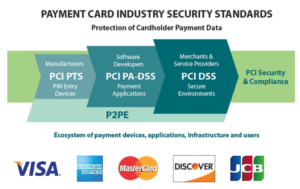In the digital age where data security is of paramount importance, ensuring your team understands and adheres to PCI-DSS standards is no longer optional but a necessity. The article “Best practices for training employees on PCI-DSS compliance” presents expert-driven strategies designed to optimize your organizational training process, enabling you to effectively prepare your team to meet and exceed these essential requirements. This invaluable guide covers multiple facets of compliance training, offering you not only a definitive understanding but also the means to instill this critical knowledge in your employees.
Understanding the Importance of PCI-DSS Compliance
The Payment Card Industry Data Security Standard (PCI-DSS) is a security standard designed to ensure that organizations that accept, process, store, or transmit credit card information protect that information effectively. It plays a crucial role in securing business transactions and protecting customer data.
Purpose of PCI-DSS compliance
Compliance with PCI-DSS is critical to maintaining trust between your organization and its customers. It ensures that your customers’ data integrity is preserved and that you’re doing everything within your power to halt unauthorized access and potential data breaches. By adhering to PCI-DSS, your organization demonstrates its commitment to maintaining high security standards and data protection.
Core principles of PCI-DSS standards
PCI-DSS standards are built on several core principles. These include maintaining a secure network, protecting cardholder data, managing vulnerability, implementing strong access control measures, regularly monitoring and testing networks, and finally, maintaining an information security policy. Ensuring these principles are met is a continuous process that requires ongoing effort and commitment.
Consequences of non-compliance
Non-compliance with PCI-DSS can have serious consequences for both your organization’s reputation and your bottom line. These can range from hefty fines, potential legal action to diminished customer confidence and loss of business. Therefore, it is essential to understand and adhere to these standards to avoid unnecessary risks.
Setting Compliance Goals are Imperative
Setting clear goals for PCI-DSS compliance is a key component of effective data security. These goals provide a defined path that your organization can follow to achieve compliance.
Setting clear, defined goals and expectations
Clear and defined goals provide a roadmap for your organization’s path to compliance. They can include measurable actions like conducting regular network scans, deploying security patches promptly, and verifying the secure handling of cardholder data.
Communicating the importance of compliance to employees
Effective communication about the importance of compliance to employees is also crucial. Equip your team with the understanding of what compliance means, why it matters, and what could happen if the standards are not met. Employees must understand their role in supporting compliance and be encouraged to align their actions accordingly.
Tracking and monitoring progress of compliance goals
Monitoring compliance goals will help you ensure that the steps your organization is taking toward compliance are effective. Regular audits, checks, and updates are important in this regard. They will not only help you spot any potential issues but also provide you with the opportunity to address them before they escalate.
Introducing Employees to PCI-DSS Regulations
Introducing employees to PCI-DSS regulations is a vital step towards achieving and maintaining compliance.
The structure of PCI-DSS standards
PCI-DSS standards are organized into six key objectives, each containing a set of specific requirements. Familiarize your employees with this structure so they understand the breadth and depth of the regulations and the scope of the compliance effort.
The role of the employee in compliance
Every employee has a role in ensuring compliance. This can range from the management who set the policies and expectations, to the frontline workers who handle cardholder data daily. Make sure everyone understands their role in upholding compliance.
Understanding common compliance challenges
While educating your team about the roles they play in compliance, it’s also important to share the common challenges organizations face in maintaining compliance and strategies to mitigate these challenges.
Comprehensive Initial Training
Meeting PCI-DSS standards requires a comprehensive initial training program that equips your employees with the knowledge and skills they need to safeguard cardholder data securely.
Guidelines for structured initial training
Initial training should provide employees with a solid understanding of PCI-DSS standards, the expectations for data security in your organization, and the consequences of non-compliance. It should also equip them with the technical skills they need to execute safe practices.
Providing thorough understanding of security measures
Training should provide employees with an understanding of the range of security measures in place, why they are necessary, and how to use them effectively. This can range from password hygiene, firewall protections, to physical security measures.
Hands-on training using company’s systems and procedures
Beyond understanding the theory of PCI-DSS compliance, hands-on training is useful in helping employees understand how to apply this knowledge in their day-to-day activities.
Continuous Employee Training
Continual reinforcement of PCI-DSS standards through ongoing training is key to maintaining a robust security posture.
Importance of ongoing training
Given the evolving nature of data security threats, it is crucial to continually update and refresh employees’ knowledge about PCI-DSS compliance.
How frequently training should be refreshed
The frequency of training should be sufficient to keep pace with changes in the security landscape. By renewing awareness and updating skills regularly, ongoing training can help sustain compliance.
Methods for effective continuous training
There are many methods to deliver effective continuous training. This could include online refresher courses, periodic workshops, or practical exercises. Choosing the most suitable methods depends on your organization’s specific needs and resources.
Providing Easy Access to Compliance Resources
Providing easy access to PCI-DSS compliance resources can help employees refresh their knowledge and remain compliant.
Maintaining an updated compliance manual
Having an updated compliance manual helps to ensure that your organization’s policies and procedures reflect the latest PCI-DSS standards. This manual should be easily accessible and employees should be encouraged to refer to it whenever necessary.
Adequate usage of online resources
There are a multitude of online resources available on PCI-DSS compliance. Ensuring that your employees know-how and where to find these resources is an effective way of keeping them informed.
Leveraging industry-proven resources and tools
Industry-proven resources and tools can also be a great help in achieving and maintaining compliance. These might include materials from regulatory bodies, other industry experts, and compliance software tools.
Promoting a Secure Culture
Creating a secure culture is vital in ensuring PCI-DSS compliance is taken seriously and maintained within an organization.
Encouraging secure practices in daily work
Encouraging secure practices such as regular password changes, vigilance for suspicious emails and maintaining secure environments can significantly contribute to the overall security posture of your organization.
Role of team leads and managers in promoting secure culture
Leaders and managers play a crucial role in promoting a secure culture. They must lead by example and foster a culture that values security and compliance.
Community engagement and sharing compliance successes
Engaging with the wider business community about your compliance successes can help boost your reputation as a trusted partner and also serve to strengthen a culture of security within your organization.
Handling PCI-DSS Non-Compliance Issues
Despite your best efforts, there may be times where issues of non-compliance arise. Knowing how to handle these situations is essential.
Potential risks and issues of non-compliance
Non-compliance could result in data breaches, loss of customer trust, and hefty fines. Identifying potential risks and issues can help in setting up contingency plans.
Proper protocols for handling breaches
In the event of a data breach, having a proper protocol to follow can ensure an efficient response. This should include steps to contain the breach, assess the impact, notify the right parties and making necessary corrections.
Learning from non-compliance issues
Any instance of non-compliance offers a learning opportunity. Analyzing why the non-compliance occurred, and revising policies or training as required, can help you strengthen your compliance efforts in the future.
Assessing Employee Compliance Skills
Regular assessment of employee’s compliance skills is a critical part of the overall compliance strategy.
Regular employee assessment and feedback
Regular assessments and feedback help employees understand where they stand in terms of compliance skills and allows them to improve in areas where they may be lacking.
Methods of evaluating employee compliance understanding
There are several ways to evaluate employee compliance understanding. This could include quizzes, practical tests, or feedback from supervisors. The results can help inform future training and identify any areas that might need additional focus.
Rewarding employees for securing data
Offering rewards for good data security practices can be an effective way to motivate employees and promote a culture of compliance.
Keeping Up-to-date with Regulations
Remaining compliant with PCI-DSS standards requires keeping up-to-date with changes in regulations.
Monitoring changes in compliance rules and regulations
Keeping an eye on updates or changes in the PCI-DSS standards is key to maintaining compliance. This can be achieved by subscribing to updates from regulatory bodies, attending relevant security conferences or joining industry forums.
Communicating updates to employees
Once updates or changes are identified, it’s important to inform your employees about these changes and how they may impact their roles and responsibilities.
Implementing new regulation in training sessions
Lastly, any changes to the regulations should be implemented in your training sessions to ensure ongoing compliance. A well-informed and educated workforce is one of your best defenses against data breaches.
In summary, ensuring PCI-DSS compliance is a continuous effort. It requires setting clear compliance goals, introducing employees to compliance regulations, providing comprehensive initial and ongoing training, promoting a secure culture, handling non-compliance correctly, and keeping up-to-date with regulations. Only then can you ensure that your organization remains compliant and your customers’ data remains secure.










